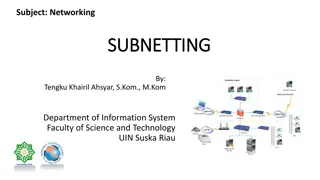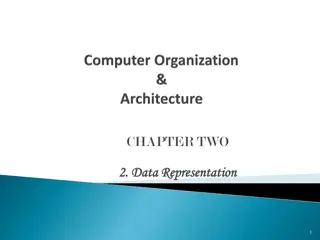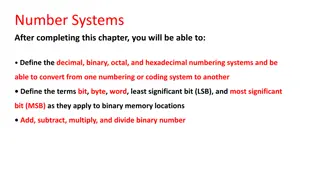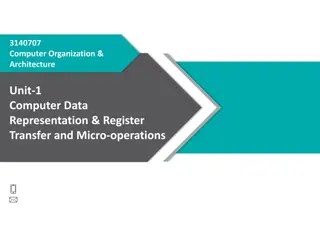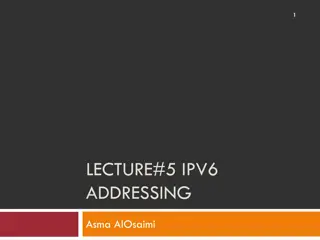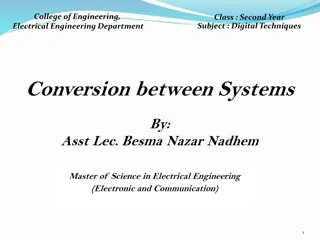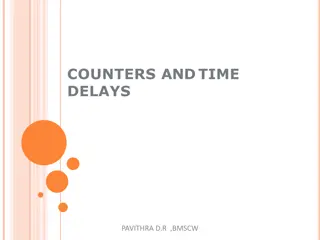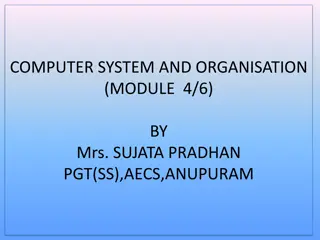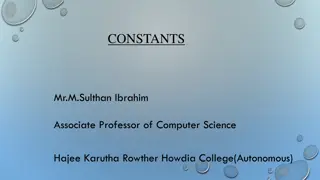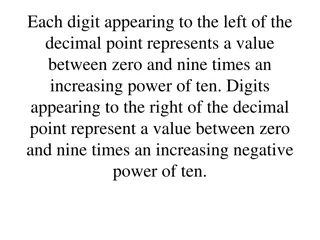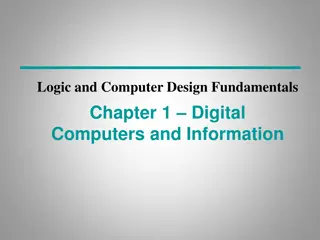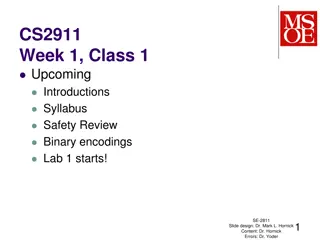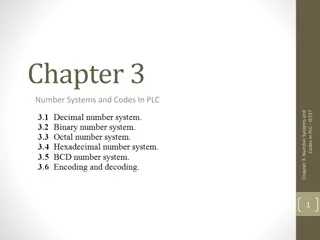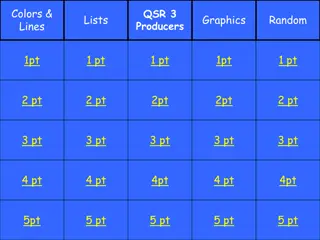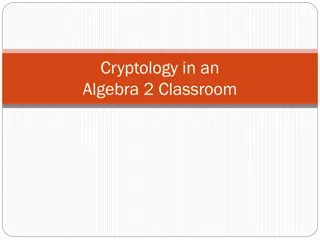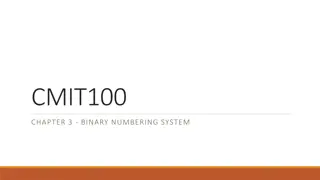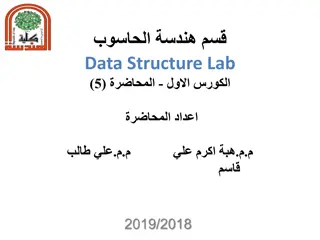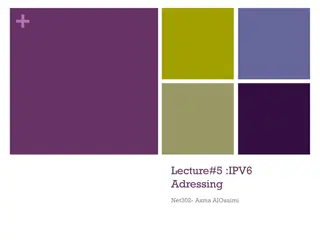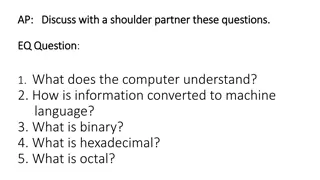Mastering Subnetting: A Comprehensive Overview
Delve into the world of subnetting with Tengku Khairil Ahsyar's course outline covering IP address conversion, subnet mask calculation, and more. Learn about binary, octal, decimal, and hexadecimal number systems along with conversion techniques. Understand the significance of subnetting for efficie
1 views • 25 slides
Understanding Binary Number System and its Applications
Explore the world of binary numbers with insights on what binary is, its significance in computing, conversion methods between binary and decimal, hexadecimal number system, and binary arithmetic operations. Dive into the foundations of digital communication through the language of zeros and ones.
0 views • 24 slides
Understanding Number Systems in Computer Science
Exploring how modern computer systems represent numeric values using various numbering systems such as binary, decimal, and hexadecimal. Discover the fundamentals of each system, their importance in digital systems, and methods for representing negative integers.
0 views • 17 slides
Understanding Number Systems in Digital Computing
Explore the decimal, binary, octal, and hexadecimal numbering systems essential for digital computing. Learn to convert between these systems, grasp terms like bit, byte, and word, and perform basic binary arithmetic operations. Visual aids and explanations make complex concepts easily understandabl
0 views • 24 slides
Comprehensive Overview of Computer Data Representation and Operations
Delve into the intricate world of computer data representation and micro-operations, covering topics such as binary, octal, and hexadecimal number systems, complements, fixed-point and floating-point representations, arithmetic and logic micro-operations, register transfer language, and more.
1 views • 70 slides
Understanding 7-Segment Displays for Beginners
Appreciate the use of 7-segment displays, which consist of 7 LEDs and a separate LED for the decimal point. Learn about common cathode and common anode displays, connections, displaying numbers, and showcasing hexadecimal values on these displays. Gain insights on how to illuminate specific segments
0 views • 13 slides
Advanced Techniques for Multiplication Performance Improvement
Explore advanced methods to enhance multiplication performance by utilizing shifts and add/subtract operations instead of traditional arithmetic. The solutions provided involve hexadecimal number pairs, demonstrating the best ways to calculate products efficiently. Furthermore, a challenge is presen
2 views • 59 slides
Understanding IPv6 Addressing and Migration Techniques
IPv6 is designed as the successor to IPv4 due to the depletion of IPv4 address space. This lecture covers topics such as the need for IPv6, IPv4 and IPv6 coexistence techniques like dual-stack, tunneling, and translation, IPv6 addressing using the hexadecimal number system, and IPv6 address represen
0 views • 30 slides
Digital Techniques for Number System Conversion in Electrical Engineering
Understand how to convert between binary, octal, decimal, and hexadecimal number systems with examples and explanations. Learn the processes of binary-to-decimal, octal-to-decimal, hexadecimal-to-decimal, decimal-to-binary, decimal-to-octal, and decimal-to-hexadecimal conversions. Gain insights into
0 views • 10 slides
Understanding Counters and Time Delays in Electronics
Explore the fundamental concepts of counters and time delays in electronic systems as explained by Pavithra D.R. from BMSCW. Learn about the design and operation of counters, time delay procedures, label states, time delay using register pairs, flowcharts for time delays, and illustrative programmin
5 views • 10 slides
Understanding Number Systems and Conversions in Computer Systems
Explore the fundamentals of number systems in computer science, including decimal, binary, octal, and hexadecimal. Learn conversion methods between different bases and practical examples like converting decimal to binary. Dive into octal-binary conversions with solved problems. Enhance your knowledg
1 views • 16 slides
Understanding Different Types of Constants in Programming
Constants in programming are fixed values that do not change during program execution. They include character, numerical, and string constants. Integer constants can be decimal, octal, or hexadecimal. This article explains each type of constant with examples of decimal, octal, and hexadecimal intege
0 views • 22 slides
Understanding Hexadecimal Numbering System
Hexadecimal numbering system provides a compact and efficient way to represent numbers, especially in computing. It uses digits 0-9 and letters A-F to represent values from 0 to 15. Converting between decimal and hexadecimal is crucial in computing, and hexadecimal numbers are widely used in binary
0 views • 88 slides
Digital Computers and Information Representation Fundamentals
Explore the basics of digital systems, number systems, arithmetic operations, and information representation in computers. Dive into binary, octal, and hexadecimal systems, along with signal processing and number system examples. Gain insights into computer organization and assembly language, utiliz
0 views • 28 slides
Understanding Binary Encodings and Internet Communication
Learn about binary encodings, sending data over the internet, bytes, hexadecimal representation, and character encoding in this informative content. Dive into the basics of representing information digitally and discover how to communicate effectively in the digital world.
0 views • 33 slides
Understanding Number Systems and Codes in PLC
Delve into the world of number systems and codes in Programmable Logic Controllers (PLC) with a focus on decimal, binary, octal, and hexadecimal systems. Learn how data is represented and manipulated in PLC applications through various numeric systems and codes. Explore the significance of bits, byt
0 views • 12 slides
Learning Colors, Lines, and Hex Codes for Design
Explore the world of colors, lines, producers, lists, graphics, and hexadecimal codes in this informative image-based content. Learn about hex codes, HTML tags for changing background and text colors, creating lists, and more. Test your knowledge with interactive examples and visuals that demonstrat
0 views • 51 slides
Introduction to Cryptology in Algebra 2 Classroom
Engage students in a high school Algebra 2 class by exploring cryptology concepts such as coding, hexadecimal systems, substitution ciphers, and the Vigenere cipher. The lesson plan includes activities like solving puzzles, introducing binary systems, converting to hexadecimal, and writing messages
0 views • 16 slides
Understanding Binary Numbering Systems and Character Representation in Computing
Explore the world of numbering systems including decimal, binary, octal, and hexadecimal, and delve into how characters are stored in computer memory. Learn about Boolean operations and their application on binary numbers, with a focus on IP addresses. Discover the importance of ASCII, Unicode, and
0 views • 26 slides
Understanding Binary Operations and Bitwise Manipulations in Programming
Exploring topics such as integers, bits, bytes, bitwise operators, signed vs. unsigned numbers, binary-hexadecimal conversion, and practical exercises to grasp essential concepts in computer programming.
0 views • 73 slides
Understanding Constants and Literals in C++ Programming
Constants and literals in C++ are fixed values that the program cannot alter. They come in various types such as integer numerals, floating-point numerals, characters, strings, and boolean values. Integer literals can be decimal, octal, or hexadecimal constants, while floating-point literals have in
0 views • 7 slides
Understanding Data Handling in Python
Types of data in Python include Number, String, List, Tuple, Set, and Dictionary. Python supports integers, floating point numbers, and complex numbers with the classes int, float, and complex. Different number systems like binary, hexadecimal, and octal are also supported. Type conversion in Python
0 views • 49 slides
IPv6 Addressing and Coexistence: Overview and Challenges
This lecture covers essential topics on IPv6 addressing, including IPv4 issues, the need for IPv6, address representation, types, testing, and verification. It explains how IPv6 is designed to overcome the limitations of IPv4, particularly the depletion of the IPv4 address space. The discussion also
0 views • 44 slides
Understanding Binary Numbers and Computer Data Representation
A computer stores information digitally as binary numbers, where data is broken down into pieces and represented as numbers. The binary system uses 0s and 1s to encode information, with each bit representing on/off states. This system is crucial for converting data into machine language. Binary numb
0 views • 14 slides
